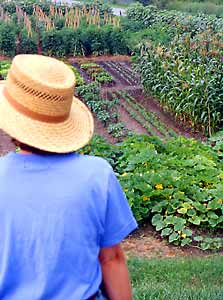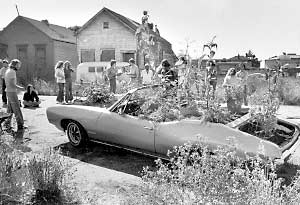
Trends in gardening come and go. Some seem truly revolutionary at first, only to fade away. Others, which don't seem earthshaking when they start, become major trends that shape gardens for years to come. So I've enjoyed looking back at the gardening scene of the late 1970s and early 1980s to see which plants, products, and trends of that era actually evolved into major importance by the year 2000. Just for fun, I've also reviewed a few popular ideas from 20 years ago that didn't make the big time, though they have still influenced some aspects of gardening today.
Of course, these lists contain my own choices and are barely the tip of the iceberg, but I hope they inspire you to take a stroll down gardening's memory lane.
Popular Plants, Old and New
One of the biggest trends over the last 20 years has been the rediscovery of heirloom plants, both ornamental and edible. As well, some new types of vegetables and fruits broke onto the scene.
Heirloom roses and vegetables. Roses led the backward look. Although many old-fashioned roses are loved for their unique shapes, irresistible fragrance, and low maintenance, they only bloom once a year. The David Austin English roses were a breakthrough, combining the characteristics of old-fashioned roses with the repeat bloom of modern hybrids. Modern shrub roses such as 'Bonica', 'Carefree Beauty', and 'Simplicity' also became popular, providing low-maintenance alternatives to hybrid teas and floribundas.
The saving of open-pollinated heirloom vegetables, spearheaded by nonprofit groups such as Seed Saver's Exchange and Native Seeds/Search, has also taken gardening by storm. This trend became so widespread that even seed company giants now devote catalogs to heirlooms. Probably the most recognized heirloom vegetable is 'Brandywine' tomato. As an example of its increased popularity, the fifth edition of Garden Seed Inventory (Seed Saver's Exchange, 1999), which lists mail-order sources for open-pollinated vegetables, listed only one source for 'Brandywine' in 1981 but 63 sources in 1998.
New Introductions
During the last two decades, not only did many new varieties of fruits and vegetables emerge, but two totally unique types of vegetables entered home gardens. Edible-pod snap peas such as 'Sugar Snap' and supersweet corns such as 'Butterfruit' have become standards in many vegetable gardens. Everbearing strawberries such as 'Tribute' and 'Tristar' and everbearing raspberries such as 'Heritage' and 'Autumn Bliss' extend the harvest season for these favorite small fruits.
New types of gardens. Cottage gardens and low-water-use (xeriscape) plantings have changed the look of gardens. In cottage gardens, old standbys such as asters, daylilies, delphiniums, and hostas mix with newer perennials such as coreopsis and ornamental grasses such as fountain grass and blood grass.
At the same time, concerns about drought and water usage have spurred interest in using native and drought-tolerant plants that require little maintenance in the landscape and the wider spread use of drip irrigation. The xeriscaping movement blossomed in the arid West and stressed planting low-maintenance, drought-tolerant plants such as Texas ranger or silverleaf (Leucophyllum), salvia, and yucca.
Although cottage gardens' loosely grown mixes of perennials, annuals, herbs, and even vegetables might seem at odds with choices for xeriscape plantings, drip irrigation means that many of the same plants--including coreopsis, ornamental grasses, penstemons, and salvia--can grow in either type of planting with minimal applications of water.
Products and Techniques
Probably the biggest change in 20 years is the strong move toward gardening in more environmentally friendly ways. Organic gardening, once practiced only by a dedicated few, today enters the consciousness of most gardeners, whether in applying compost or other organic amendments to the soil or in dealing with pests without recourse to heavy-duty pesticides. Other changes include some new products that simplify watering and maintenance, new techniques that allow gardening in smaller spaces, and information that comes to us through a variety of mediums.
Pest, climate, and weed control. Among environmentally friendly products that have come on the market over the past 20 years are Bacillus thuringiensis 'San Diego' to control Colorado potato beetles, neem oil and insecticidal soap to control a wide range of insects, and traps to control Japanese beetles and apple maggots. In short, we've matured from those starry-eyed days of believing anything natural or botanical was good, to understanding the best ways to use beneficial insects, biological and botanical sprays, and insect traps.
Multiuse plastic row covers. Floating row covers, first used commercially and then picked up for home gardens, are now widely used for pest and weed control; they can also extend the growing season. Spun-bonded polyester row covers such as Reemay protect crops from insects, while keeping the crops warmer. Plastic mulches jump-start warm-season crops such as tomatoes; initially available only in black and white, they now come in more colorful, and effective, hues such as dark green and red.
String trimmers. These hand-held power tools became widely available to home gardeners during the mid-1970s. They were an almost instant hit and are so commonplace today that it's hard to imagine a world without them. They fell weeds and create gardens with cleaner edges, but do so with more noise than manual equipment, and improper use can kill trees.
Smaller Gardens
Gardens have been shrinking, in part because of higher land costs, but mostly because fewer gardeners have enough time to maintain them. But that doesn't mean you have to grow less: for many smaller-space gardeners, the bible was the book Square-Foot Gardening, by Mel Bartholomew (1981), which is still a best-seller. Intensive gardening came into vogue, especially for vegetables and annuals. And gardeners with limited space now grow every plant imaginable, from herbs to trees, in containers on patios, decks, or rooftops.
New Sources of Information
Although books and magazines continue to be popular, how we get our gardening information has changed. James Crockett and the Victory Garden television show burst on the scene in 1974, and the show has been going strong ever since, spurring many other gardening shows to hit the airwaves. Now an entire television network (HGTV) is devoted to home and gardening.
In the late 1970s, who would have thought that computers would become so ubiquitous in people's lives? Information, plants, seeds, and products are now only a keystroke away with university, nonprofit, and private company Web sites devoted specifically to gardening.
 Changing Trends
Changing Trends
Not all gardening ideas from the 1970s and 1980s made it to the 21st century. But some didn't fade away, either; they were transformed over the decades into more sophisticated versions. Let's take a look at a few.
Geodesic domes. Those Buckminster Fuller inspired structures for people and plants were a sign of the 1970s back-to-the-land movement. The domes and the lifestyle associated with them aren't as popular as they used to be, but the desire to live under glass with good-looking plants is still strong, manifested in the growing use of solariums and green rooms in homes.
Self-sufficiency, food preservation, and recycling. Do you remember tire gardens--tires placed around vegetable plants to extend the season? Today's gardening lifestyle is more about growing attractive, unusual vegetables, herbs, and flowers not with an eye to preserve or sustain us through the winter, but for their beauty, freshness, and taste at the moment they're picked. And instead of using recycled milk jugs and old tires, we now adorn our gardens with benches and trellises made from recycled plastic.
Milkweed pods never did become trendy, but one current rage that relates to nature is the increasing use of wild, medicinal plants such as echinacea and St. Johns-wort, as well as interest in specialty wild greens such as dandelion and arugula, and in nutrient-rich crops such as carrots and broccoli.
Gone and best forgotten: Finally, some ideas may be better left in the mists of obscurity. Raise your hand if you remember any of these fads: macrame plant hangers, tomato-potato plants, plastic grow-bags, or fern bars (houseplant ferns hanging everywhere!).
Time-Tested Hits
Are you still growing any of these flower and vegetable varieties? These were All-America Selections winners from 1975 to 1985:
'Premium Crop' broccoli (1975)
'Queen Sophia' marigold (1979)
'Nicki Red' nicotiana (1979)
'Sugar Snap' pea (1979)
'Apricot Brandy' celosia (1981)
'Blitz' impatiens (1981)
'Gypsy' pepper (1981)
'Sweet Success' cucumber (1983)
'Sugar Ann' pea (1984)
'Celebrity' tomato (1984)
'Red Sails' lettuce (1985)
'Sunburst' summer squash (1985)
Charlie Nardozzi is senior horticulturist at National Gardening.
Photography by John Goodman and National Gardening Association.
 Charlie Nardozzi is an award winning, nationally recognized garden writer, speaker, radio, and television personality. He has worked for more than 30 years bringing expert gardening information to home gardeners through radio, television, talks, tours, on-line, and the printed page. Charlie delights in making gardening information simple, easy, fun and accessible to everyone. He's the author of 6 books, has three radio shows in New England and a TV show. He leads Garden Tours around the world and consults with organizations and companies about gardening programs. See more about him at Gardening With Charlie.
Charlie Nardozzi is an award winning, nationally recognized garden writer, speaker, radio, and television personality. He has worked for more than 30 years bringing expert gardening information to home gardeners through radio, television, talks, tours, on-line, and the printed page. Charlie delights in making gardening information simple, easy, fun and accessible to everyone. He's the author of 6 books, has three radio shows in New England and a TV show. He leads Garden Tours around the world and consults with organizations and companies about gardening programs. See more about him at Gardening With Charlie.
 Victory Seed Company has all the seeds you want for your best garden in 2024.
Victory Seed Company has all the seeds you want for your best garden in 2024.
For 25 years, the family-owned Victory Seed Company has provided the highest quality vegetable, herb and flower seeds to families across the country. We are passionate about providing you the best seeds available that give excellent germination, robust plants, and the harvest you want. With a catalog of over a thousand varieties, we have everything, and our prices are the kinds that we'd want to pay. We have hundreds of yesterday's heirloom vegetables, as well as today's award winning hybrid selections. Get to know us by visiting our website and browsing through our online vegetable seed catalog.